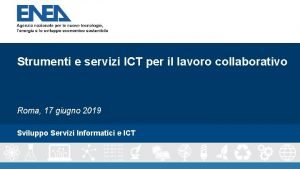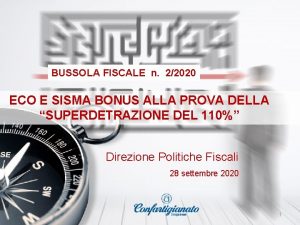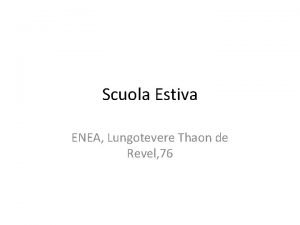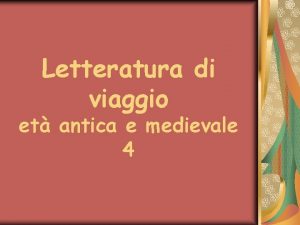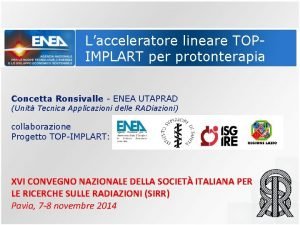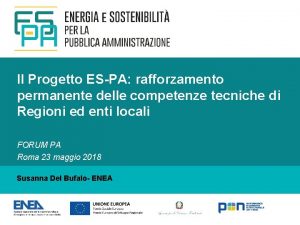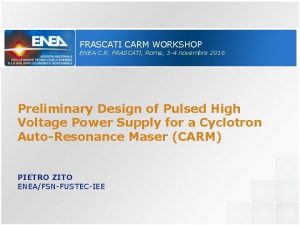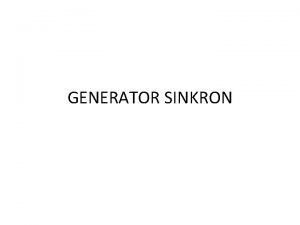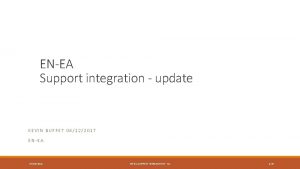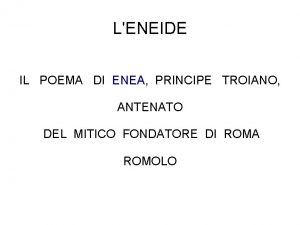The Frascati Neutron Generator ENEA Frascati Research Centre




![References [1] M. Martone, M. Angelone, M. Pillon, J. Nucl. Mat. 212 -216, 1661 References [1] M. Martone, M. Angelone, M. Pillon, J. Nucl. Mat. 212 -216, 1661](https://slidetodoc.com/presentation_image_h2/2449c3a6ca962c77ef16cfbfa661e59e/image-5.jpg)
- Slides: 5

The Frascati Neutron Generator ENEA Frascati Research Centre Presenter M. Pillon

The Frascati Neutron Generator (FNG) started operations in November 1992 making available 14 Me. V neutrons at a medium intensity (1011 n/s) to EU Fusion Community. The Fusion Neutronics community strongly supported the idea of international collaboration in neutronics experiments, data base & code improvement, development of (new) experimental techniques and detectors. FNG was designed in ENEA (FSN Department) that also builted and operates the machine at its own expenses. FNG has been (and is) extensively used to perform benchmarks or mockup experiments of interest to Fusion neutronics in turn validating Nuclear Data and Codes. A number of activities in different fields within a series of collaborations are carried out at FNG so far.

1. 2. 3. 4. 5. 6. 7. 8. HV TERMINAL ION SOURCE CHAMBER –EINZ LENS BENDING MAGNET ACCELERATOR TUBE VACUUM PUMP QUADRUPOLE TARGET FNG is a linear electrostatic acceleator-driven rneutron source where D+ ions are accelerated up to about 300 ke. V at a current of about 1 m. A and directed onto a tritium/deuterium containing target where neutron are produced by means of fusion reactions. When FNG is operated with a tritium containing target, the source can produce up to 1. 0× 1011 n/s at 14 Me. V via the nuclear fusion reaction: D+T a+n (Q=17. 4 Me. V) The FNG neutron source is almost isotropic, its absolute strength is calibrated at ± 3% using the Associated Particle method. FNG can also produce 2. 5 Me. V neutrons by using deuterium containing targets by means of the fusion reaction: D+D n + 3 He (Q=4. 03 Me. V). In this case the neutron yield is 1× 109 n/s, about a factor 100 less intense (smaller cross section with respect to D-T reaction).

FNG Lab Activities Benchmark experiments for ITER: Stainless steel bulk shielding, Nuclear heating, Shut down dose rate; Activation experiments on fusion relevant materials: SS-316 (IG), F 82 H, MANET, EUROFER, Fe, Cu, V & V-alloys, Si. C, W, Al, Cr, Pb; Design oriented benchmark experiments in support of ITER nuclear design; Experiments for validation of EFF / EAF nuclear data libraries and for Advanced Materials. Not fusion related activities Chip irradiation: NUCLETUDE (France) used FNG to irradiate components for AIRBUS; Radiation hardness for detection system: J-LAB (US) team irradiated Si. PM based detector readout to assess radiation hardness; Oil extraction tubes: TRACERCO (UK) irradiated double layer thick tube sections used for oil extraction to see water content by means of fast neutron induced Oxygen activation; Biology: in-vivo mice irradiation for DNA damaging studies. Detector development Fast Neutrons: Single Crystal Diamond detectors for Plasma Fusion diagnostics; Single Crystal Diamond detectors for in-core fast fission reactor diagnostics; Gas Electron Multipliers (GEM) for 2. 5 Me. V (D-D) and 14. 0 Me. V (D-T) neutron detection. Thermal neutrons (He-free): Gas Electron Multipliers (GEM) for high-efficiency neutron detection; Detectors based on Radiative Neutron Capture; Single crystal neutron detectors with Li. F coating; Semiconductors (Ga. As) and supercondutors (Nb, Nb. N) neutron detectors; Resistive Plate Chambers (RPC). An “ad hoc” source routine was implemented in MCNP. This routine accounts for all the physical aspects of the neutron production from the beam-target interaction, including ions scattering, fusion cross-section anisotropy, etc. In the MCNP geometry the target holder and the used detectors dimensions and materials are also described. The Source routine was developed by ENEA Frascati and Institut Jozef Stefan (JSI) in Ljubljana and is available in SINBAD database at NEA.
![References 1 M Martone M Angelone M Pillon J Nucl Mat 212 216 1661 References [1] M. Martone, M. Angelone, M. Pillon, J. Nucl. Mat. 212 -216, 1661](https://slidetodoc.com/presentation_image_h2/2449c3a6ca962c77ef16cfbfa661e59e/image-5.jpg)
References [1] M. Martone, M. Angelone, M. Pillon, J. Nucl. Mat. 212 -216, 1661 (1994). [2] P. Batistoni, M. Angelone et al. , Fus. Eng. Des. 47, 25 (1999). [3] M. Angelone, P. Batistoni, L. Petrizzi, M. Pillon, Fus. Eng. Des. 42, 255(1998) [4] M. Angelone, M. Pillon et al. Nucl. Instr. Meth. A 623, 921 (2010). [5] A. Pietropaolo, G. Claps et al. Nucl. Instr. Meth. A 729, 117 (2013).
